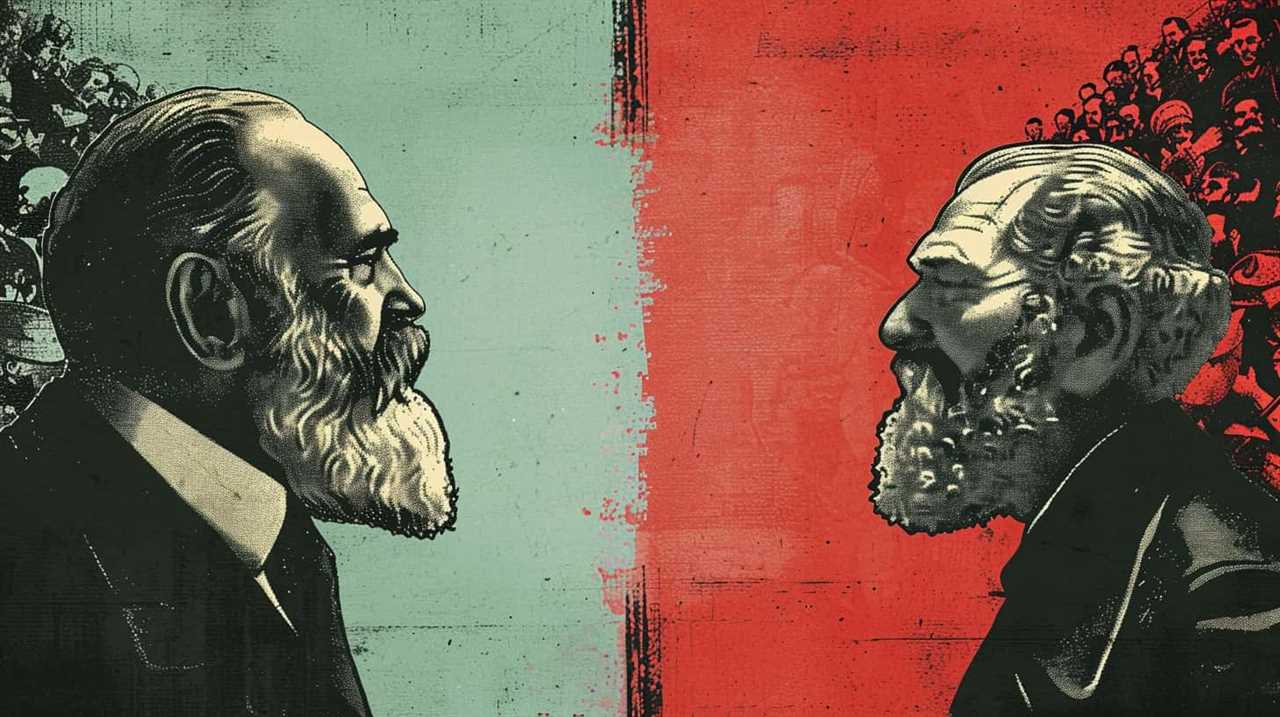By chance, while exploring the complex realm of strategic business decisions, we come across a powerful tool that can help steer our decision-making process – Nash Equilibrium.
In this quest for mastery, we shall unlock the secrets of leveraging this concept to our advantage. By understanding Nash Equilibrium, we gain insight into the interplay of decision-makers and the role of competition in shaping our strategies.
With this knowledge, we can mitigate risks and make informed pricing decisions. Through case studies of successful applications, we will witness the transformative impact of Nash Equilibrium in the business landscape.
So, let us embark on this journey of discovery, where the mastery of Nash Equilibrium empowers us to make strategic business choices with confidence and precision.

Key Takeaways
- Nash Equilibrium is a fundamental principle in game theory that helps analyze strategic decision-making in various domains.
- It provides a framework for making strategic business choices by identifying stable points where all players’ strategies are mutually best responses.
- Rational decision-making involves making logical and informed choices, minimizing biases, and considering trade-offs.
- Applying game theory to business choices, such as strategic pricing, market entry strategies, and negotiation tactics, maximizes profits and enhances decision-making.
Understanding Nash Equilibrium
We will now explore the concept of Nash Equilibrium, which is a fundamental principle in game theory that helps us analyze strategic decision-making in business. Nash Equilibrium isn’t limited to business scenarios; it also plays a crucial role in social dynamics and political decision-making.
In social dynamics, Nash Equilibrium refers to a state where individuals or groups reach a stable outcome by making decisions that maximize their own benefits, considering the actions of others. This concept helps us understand how social interactions, such as cooperation, competition, and conflict, can lead to equilibrium.
Similarly, in political decision-making, Nash Equilibrium can be applied to analyze situations where multiple political actors make strategic choices to maximize their own interests. By understanding Nash Equilibrium, we can gain insights into the behavior and outcomes of individuals, groups, and even nations in various contexts.
This knowledge is invaluable for businesses, as it allows them to anticipate and respond to the strategic moves of competitors, customers, and other stakeholders. By leveraging Nash Equilibrium, businesses can make informed decisions to gain a competitive advantage and achieve long-term success.

The Concept of Strategic Decision-Making
When it comes to strategic decision-making, rationality plays a crucial role in ensuring optimal outcomes. By considering the potential outcomes and payoffs of different choices, businesses can use game theory applications to analyze the strategic landscape and make informed decisions.
Understanding the concept of Nash equilibrium allows us to identify the stable points where all players’ strategies are mutually best responses, providing a framework for making strategic business choices that maximize long-term success.
Rationality in Decision-Making
One key aspect of strategic decision-making is the use of rationality in analyzing choices. Rationality in decision-making refers to the process of making logical and informed decisions based on objective analysis and consideration of available information. It involves minimizing decision-making biases that can cloud judgment and lead to suboptimal outcomes.
To achieve rational decision-making, it’s important to:

- Identify and acknowledge cognitive biases: Awareness of biases such as confirmation bias, anchoring bias, and overconfidence bias allows decision-makers to mitigate their impact and make more objective choices.
- Gather and analyze relevant data: Making decisions based on accurate and reliable data ensures that choices are grounded in facts rather than assumptions or personal biases.
- Evaluate alternatives and consider trade-offs: Rational decision-making involves carefully assessing different options and weighing their potential risks and benefits.
Game Theory Applications
Game theory applications provide valuable insights for strategic decision-making in business. By utilizing game theory, managers can analyze and understand complex interactions between competitors, customers, and suppliers. This allows them to make informed decisions to maximize their own outcomes while considering the behavior of others.
Game theory models help in identifying Nash equilibrium, which represents the strategy that no player would want to deviate from given the strategies of the other players. Rationality in decision-making is a fundamental assumption in game theory, where individuals are assumed to make choices based on logical reasoning and self-interest.
Applying Game Theory to Business Choices
At our company, we actively apply game theory to make strategic business choices. By leveraging game theory applications, we can analyze and optimize our decision-making process, ultimately maximizing profits. Here are three ways we apply game theory to our business choices:
- Strategic Pricing:
Game theory helps us determine the optimal pricing strategy by considering the actions and reactions of our competitors. By modeling their potential responses to our pricing decisions, we can identify the price point that maximizes our profits while maintaining a competitive edge. - Market Entry:
When considering entering a new market, game theory enables us to assess the potential outcomes and predict the behavior of existing players. By strategically analyzing their possible reactions, we can identify the best entry strategy that minimizes risks and maximizes our chances of success. - Negotiation Tactics:
Game theory also plays a crucial role in our negotiation tactics. By understanding the incentives and motivations of the other party, we can strategically determine our moves to achieve favorable outcomes. This allows us to engage in mutually beneficial negotiations that maximize our gains while considering the interests of all parties involved.
Key Principles of Nash Equilibrium
When applying Nash Equilibrium to strategic business choices, we focus on the key principles that govern optimal decision-making in competitive situations. Understanding equilibrium dynamics and strategic decision analysis is crucial in navigating complex business scenarios.

One of the key principles of Nash Equilibrium is the concept of mutual best response. This principle states that each player in the game, when faced with the strategies chosen by the other players, selects the strategy that maximizes their own payoff. This ensures that no player has an incentive to unilaterally deviate from their chosen strategy.
Another principle is the idea of stability. Nash Equilibrium represents a stable state where no player can improve their payoff by changing their strategy, given the strategies chosen by the other players. This stability ensures that the game settles into a predictable outcome.
Lastly, the principle of rationality assumes that all players are rational decision-makers who act in their own self-interest. This assumption allows for the analysis of strategic behavior and helps predict the actions of other players in a competitive setting.
By understanding these key principles of Nash Equilibrium, businesses can make informed strategic decisions, anticipate their competitors’ actions, and maximize their own outcomes in competitive environments.

| Key Principles of Nash Equilibrium | ||
|---|---|---|
| Mutual Best Response | Stability | Rationality |
Identifying Interdependent Decision-Makers
To effectively leverage Nash Equilibrium in strategic business choices, we must identify the interdependence between decision-makers. Understanding the dynamics between interdependent players is crucial in order to make informed decisions that align with the goals and objectives of the organization.
Here are three key factors to consider when identifying interdependent decision-makers:
- Relationship networks: Analyze the connections and relationships between decision-makers within and outside the organization. Identify who’s influence over whom and how this can impact decision-making processes.
- Information sharing: Examine how information flows among decision-makers. Determine who’s access to critical information and how it’s disseminated. This can help identify power dynamics and potential conflicts of interest.
- Decision-making power: Assess the level of decision-making power that each player holds. Identify who’s the authority to make final decisions and who may have veto power. Understanding the distribution of decision-making power is essential in predicting behavior and potential outcomes.
Analyzing Payoff Matrix in Business Scenarios
When analyzing the payoff matrix in business scenarios, it’s crucial to determine the optimal decision-making strategies that will maximize our profits.
By understanding the impact of our competitors’ choices on our own outcomes, we can strategically plan our actions to gain a competitive advantage.

Through careful analysis of the payoff matrix, we can identify the most profitable courses of action and make informed strategic decisions to achieve our business objectives.
Optimal Decision-Making Strategies
In the article, we analyze the payoff matrix in various business scenarios to determine optimal decision-making strategies. Rational decision-making is crucial in the business world, and understanding the techniques to make informed choices is essential for success.
Here are three key points to consider when developing optimal decision-making strategies:
- Evaluate the potential outcomes: By thoroughly analyzing the payoff matrix, we can assess the potential gains and losses associated with each decision. This allows us to make informed choices based on the expected outcomes.
- Consider the preferences and goals: It’s important to align our decision-making strategies with our business objectives and preferences. By taking into account our desired outcomes and priorities, we can make choices that maximize our chances of success.
- Assess the risks and uncertainties: Decision-making involves inherent risks and uncertainties. By carefully considering the potential risks and uncertainties associated with each decision, we can develop strategies that mitigate these risks and increase our chances of achieving favorable outcomes.
Impact of Competitor Choices
We analyze competitor choices by analyzing the payoff matrix in business scenarios. Understanding the impact of competitor analysis is crucial for strategic positioning in the market. By examining the choices made by competitors, we can identify potential opportunities and threats that can affect our own business decisions.

The payoff matrix provides a visual representation of the possible outcomes based on different choices made by both us and our competitors. It allows us to assess the potential payoffs and risks associated with each decision, enabling us to make more informed strategic choices.
By analyzing the payoff matrix, we can identify the Nash equilibrium, which represents the optimal outcome where no player can achieve a better payoff by changing their strategy. This analysis helps us maximize profits and gain a competitive advantage in the market.
In the subsequent section, we’ll explore how to maximize profits through analysis, utilizing the insights gained from competitor choices and the payoff matrix.
Maximizing Profits Through Analysis
To maximize profits, we leverage the analysis of the payoff matrix in business scenarios. By carefully examining the outcomes of different strategic choices, we can identify the most profitable path forward.

Here are three key ways in which we can use this analysis to our advantage:
- Maximizing market share: Through the analysis of the payoff matrix, we can determine the optimal pricing and positioning strategies to gain a larger share of the market. This involves identifying the right balance between pricing competitively and offering unique value propositions.
- Strategic product positioning: The payoff matrix analysis helps us understand how different product positioning strategies can impact our profitability. By evaluating the potential outcomes, we can identify the positioning that maximizes our profits and sets us apart from our competitors.
- Identifying competitive advantages: Analyzing the payoff matrix allows us to identify our strengths and weaknesses compared to our competitors. This information enables us to focus on leveraging our competitive advantages and mitigating our weaknesses, ultimately leading to increased profitability.
Achieving Optimal Outcomes Through Strategic Choices
By strategically choosing our actions, we can secure optimal outcomes. Achieving competitive advantage in the business world requires a strategic decision-making framework that considers various factors and potential outcomes. To achieve optimal outcomes, businesses must carefully analyze the market, their competitors, and their own capabilities.
One key aspect of achieving optimal outcomes is understanding the concept of Nash Equilibrium. In strategic decision making, Nash Equilibrium represents a state in which no player can improve their outcome by unilaterally changing their strategy. By identifying the Nash Equilibrium in a given situation, businesses can make informed choices that maximize their chances of success.
Strategic choices should be based on a thorough analysis of the market and an understanding of the competitive landscape. This involves evaluating factors such as customer needs, market trends, and competitor behavior. By identifying potential opportunities and threats, businesses can make decisions that give them a competitive advantage.

Furthermore, businesses must consider the long-term implications of their choices. While short-term gains may be tempting, it’s crucial to evaluate the sustainability and scalability of the chosen strategy. Optimal outcomes aren’t just about immediate success but about creating a strong foundation for future growth.
Recognizing the Role of Competition in Decision-Making
Competition plays a crucial role in shaping decision-making processes for businesses. Recognizing the role of competition is essential for understanding the dynamics that drive strategic choices. Here are three key points to consider:
- Competitive Landscape: Understanding the competitive landscape is vital for making informed decisions. It involves analyzing competitors’ strengths, weaknesses, and market positioning. This knowledge helps businesses identify opportunities, anticipate threats, and develop effective strategies to gain a competitive edge.
- Collaboration Opportunities: While competition can be fierce, it also creates opportunities for collaboration. Strategic alliances and partnerships can enable businesses to pool resources, share knowledge, and leverage complementary strengths. Collaboration can lead to innovation, cost savings, and market expansion, enhancing decision-making processes.
- Decision-Making Biases: Competition can sometimes lead to decision-making biases. The fear of losing market share or being outperformed by competitors can cloud judgment and result in irrational choices. Recognizing and mitigating these biases is crucial for making sound strategic decisions that align with long-term goals.
Mitigating Risks With Nash Equilibrium Strategies
When considering the role of competition in decision-making, we recognize that mitigating risks with Nash Equilibrium strategies is crucial for achieving optimal outcomes. Mitigating risk is a fundamental aspect of strategic business choices, as it allows organizations to navigate uncertain and volatile environments with confidence. By utilizing Nash Equilibrium strategies, which involve analyzing the potential actions and reactions of competitors, organizations can proactively identify and address potential risks before they materialize.
One key strategy for mitigating risk is to carefully evaluate the potential payoffs and outcomes of different decision-making scenarios. This involves considering the potential actions and reactions of competitors, as well as the potential impact on market dynamics. By understanding the various possible outcomes and their associated probabilities, organizations can make more informed decisions and minimize the likelihood of negative outcomes.

Another important aspect of mitigating risk with Nash Equilibrium strategies is the concept of strategic interdependence. This refers to the interplay between an organization’s actions and the actions of its competitors. By strategically aligning their decisions with the potential actions and reactions of competitors, organizations can reduce the potential for adverse outcomes and increase the likelihood of achieving their desired objectives.
In conclusion, mitigating risk through Nash Equilibrium strategies is an essential component of effective decision-making in competitive environments. By carefully evaluating potential outcomes, considering strategic interdependence, and proactively addressing potential risks, organizations can position themselves for success.
In the next section, we’ll explore how organizations can leverage Nash Equilibrium in pricing decisions to further optimize their strategic choices.
Leveraging Nash Equilibrium in Pricing Decisions
When it comes to pricing decisions, leveraging Nash Equilibrium can help businesses determine the optimal pricing strategies in competitive market dynamics.

By analyzing the interplay of pricing decisions among competitors, businesses can identify the equilibrium point where no player has an incentive to deviate from their chosen price.
This allows businesses to strategically set their prices to maximize their profits while considering the reactions of their competitors, ultimately leading to a more effective pricing strategy.
Optimal Pricing Strategies
We can leverage Nash Equilibrium to determine the optimal pricing strategies for our business. By understanding the pricing models and market segmentation, we can strategically set our prices to maximize profits and gain a competitive advantage.
Here are three key considerations when developing our pricing strategies:

- Market Analysis: Conduct a thorough analysis of the market to identify our target customers and their willingness to pay. This will help us determine the optimal price point that balances customer demand and profitability.
- Competitor Pricing: Analyze our competitors’ pricing strategies to identify any pricing gaps or opportunities for differentiation. By strategically positioning our prices relative to our competitors, we can attract customers and capture market share.
- Elasticity of Demand: Consider the price elasticity of demand to determine how sensitive our customers are to changes in price. This will help us understand the potential impact of price changes on customer demand and adjust our pricing accordingly.
By incorporating these factors into our pricing decisions, we can effectively leverage Nash Equilibrium to optimize our pricing strategies and drive business growth.
In the subsequent section, we’ll explore how competitive market dynamics influence our strategic business choices.
Competitive Market Dynamics
To understand competitive market dynamics and leverage Nash Equilibrium in pricing decisions, we must analyze the interplay between market forces and strategic pricing choices.
Competitive advantage and market share analysis are essential components of this analysis. Competitive advantage refers to the unique strengths and capabilities that enable a company to outperform its competitors. By understanding their competitive advantage, companies can strategically position their pricing to maximize profitability and market share.

Market share analysis involves evaluating a company’s market position relative to its competitors and identifying opportunities to gain or maintain market share through pricing strategies.
By leveraging Nash Equilibrium, companies can strategically set prices that optimize their competitive position while considering the reactions of their competitors.
In the next section, we’ll explore case studies that demonstrate successful applications of Nash Equilibrium in business, providing practical insights into its effectiveness.
Case Studies: Successful Applications of Nash Equilibrium in Business
The successful applications of Nash Equilibrium in business have demonstrated the power of strategic decision-making based on game theory. Through various case studies, we can see how this concept has been effectively employed to optimize outcomes and gain a competitive edge.

Here are three noteworthy examples:
- Pricing Strategy: In the airline industry, companies have used Nash Equilibrium to determine optimal pricing strategies. By analyzing competitors’ pricing decisions and passenger demand, airlines can strategically set their own ticket prices to maximize revenue while remaining competitive in the market.
- Advertising Campaigns: Nash Equilibrium has also been applied in the design of advertising campaigns. Companies analyze their competitors’ advertising efforts and consumer responses to determine how much to invest in advertising and which channels to prioritize. This allows businesses to allocate their advertising budgets effectively and reach their target audience more efficiently.
- Supply Chain Management: Nash Equilibrium has proven valuable in optimizing supply chain decisions. By considering the actions of suppliers, manufacturers, and distributors, companies can determine the optimal distribution of resources, minimize costs, and ensure efficient operations throughout the supply chain.
These successful case studies highlight the strategic value of Nash Equilibrium in making informed business decisions. By understanding and leveraging game theory principles, companies can gain a competitive advantage and achieve desired outcomes.
Frequently Asked Questions
What Is Nash Equilibrium and How Does It Relate to Strategic Business Choices?
Nash equilibrium is a concept in game theory that describes a state where no player can improve their outcome by unilaterally changing their strategy. It relates to strategic business choices by providing a framework for optimal decision-making in competitive environments.
How Can Game Theory Be Applied to Business Decisions?
When it comes to game theory applications in business decisions, our team understands the importance of strategic decision-making strategies. We leverage game theory to analyze complex scenarios and identify optimal solutions for our clients.

What Are the Key Principles of Nash Equilibrium?
The principles of Nash Equilibrium are key to strategic decision-making. By understanding the concept of players optimizing their outcomes based on others’ choices, businesses can leverage this equilibrium to achieve their own goals.
How Can Interdependent Decision-Makers Be Identified in a Business Scenario?
Identifying dependencies and conducting decision-making analysis are crucial in a business scenario. By understanding the interdependence of decision-makers, we can make strategic choices that leverage Nash Equilibrium to achieve optimal outcomes and gain a competitive advantage.
How Can Nash Equilibrium Be Leveraged in Pricing Decisions?
To leverage Nash Equilibrium in pricing decisions, we must understand the competition dynamics and market positioning strategies. By identifying the optimal pricing strategy that maximizes profits, we can gain a competitive edge in the market.
Conclusion
In conclusion, leveraging Nash equilibrium in strategic business choices allows decision-makers to analyze and understand the interplay of competition and interdependence.

By applying game theory principles, businesses can mitigate risks and make informed pricing decisions.
Through case studies, we’ve seen successful applications of Nash equilibrium in various industries.
It’s evident that this strategic approach offers a concise and analytical framework for making effective business decisions.
Lauren’s talent in writing is matched by her passion for storytelling. Her love for books and deep understanding of culture and entertainment add a distinct flavor to her work. As our media and press contact, Lauren skillfully bridges the gap between afterQuotes and the broader media landscape, bringing our message to a wider audience.








